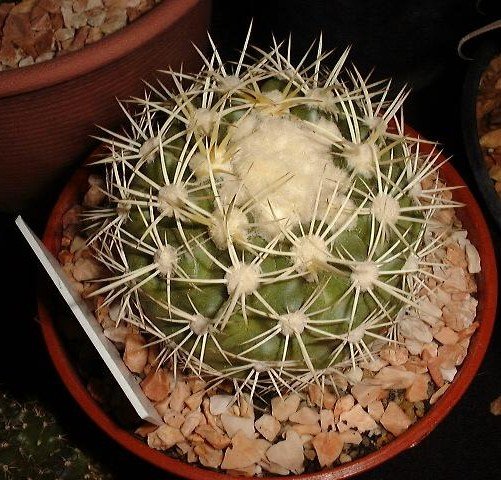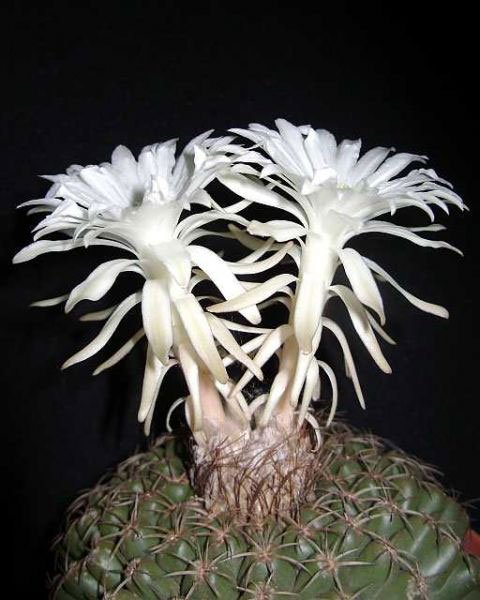Disco Cactus is also known as subterraneo-proliferans. These cactus is native to latin America, expecially found in Brazila and Bolivia.
The Discocactus subterraneo-proliferans is recognized as one of the rarest and most expensive succulents.
According to the International Union for Conservation of Nature or IUCN, the cactus is classified as critically-endangered.
The plant originally comes from Brazil. Unfortunately, it is believed that this succulent is already extinct in its native habitat due to cattle ranching and small-scale agriculture.
Today, it is believed that the total number of specimens is around 50 pieces, belonging to a handful of collectors who are working hard to propagate it.
How to Identify Discocactus?

Due to its rarity, not much is known about the Discocactus subterraneo-proliferans. But, according to our research, it has a sphere structure with spines.
The body diameter could be of 10 cm where as spines could grow up to 0.5 to 1.5 cm.
Where can I buy a Discocactus?
There are plenty of websites from where you can purchase a cactus from. Let me tell you some of the best websites from where you should buy these cacti. Some of the popular websites are enlisted below:
- Amazon
- Etsy
If you are looking for free shipping offers for a discocactus, bunnings can be your choice. You can also find these cacti from your nearest local markets.
Caring Routine for the Disco cactus
The caring routine for the disco cactus is not that complicated and all you need to do is keep in mind the basic gardening facts about the cactus while you plant it.
Let us quickly begin with the key points now.
Light
To attain the best of its health, the cactus must be placed in full sunlight. The intensity of the sun is preferred by the cacti but it can also do well in a shade if cannot get a complete exposure.
However, it is important to take good care of the plant during the summer season. You cannot afford to keep it exposed to the tremendous heat of the sun for more than 5 hours a day.
If you are not careful enough the cactus will get damaged and may even die. If you are growing it in your interior home garden, make sure you place it in a bright spot to get full sun exposure.
Temperature and Humidity
Warm temperatures are preferred by this cactus and 50ºF is supposed to be an ideal one.
Low humidity levels are alright for the cactus high levels of humidity is dangerous as it may cause excessive moisture retention in the soil causing rot root.
Watering
Water a lot during the summer season but make it less and only when needed during the winters.
Overwatering can kill your plant, so be cautious!
Also, you should not underwater as it will definitely make the cactus wilt.
Soil Preparation
A soil mixture with well-draining properties is the ideal one for a succulent. You may use a cactus soil mix, or a combination of sand, potting mix, and pumice for preparing the soil for your cactus.
A portion of organic matter can be used to provide sufficient minerals to the plant.
Fertilizer
The cactus doesn’t require to be fed always and only requires fertilizers during the active growth phase.
A liquid fertilizer halved to its strength by adding water can be used to enhance the growth of your cacti plant.
Diseases and Pest Control
The best thing about a cactus is that they would not get diseases because you lacked caring. But still, there are some diseases that affect every cactus plant.
Let me notify some of them so that you can take early precautions to avoid these diseases.
- Sunburn – Due to excessive exposure to direct sunlight.
- Desiccation – Due to lack of watering.
- Frost Damage – Due to freezing temperature.
- Corking – Cactus turned brown due to the dryness and harsh sunlight.
Sometimes gardeners also witness damages from insects in the apical meristem which may cause a cell mutation, but it’s rare.
If you find the cactus dying, there may be numerous problems like environmental conditions, fungus, bugs, and some diseases. However, if you care well, the diseases can be avoided.
This species of cactus is sensitive to red spiders. Aphids, Caterpillars, Nematodes, Slugs, and snails are also some pests that can affect your cactus.
You can use natural insecticides like neem oil to prevent them.
Potting and Re-potting
You do not require a big container as the roots are shallow and an unglazed pot would be the best for its plantation.
Once you notice roots coming out of the pot, it’s probably time to re-pot the plant. Be gentle while you remove the plant from its existing pot. If you are not careful, you can hurt yourself as an adult cactus has a lot of spines.
Now, place it in the new pot and add some freshly prepared potting mix. Wait for sometime before you start watering it. After 1-2 weeks start watering following a definite routine.
Propagation
Do you want to know how to propagate discacoctus? Propagating a cactus is something different from other cacti plants due to its crested structure.
A creative approach needs to be made to propagate. Let me guide you through this.
- Start by cutting a portion of the stem, a bit longer in size, with a grafting knife.
- Now, you will find a ring-like thing on both sides of the cut piece. You need to overlap them for propagating.
- You need to layer it on top of an existing cactus You can use a rubber band to tie the 2 pieces together and hold them in place.
- After few months, the pieces will get joined.
You can propagate your Subterraneo Proliferans in some other ways as well, but grafting works the best for the propagation of the succulent.
Flowering & Blooming
A healthy plant will always flower and the blooming will also be in the appropriate season and time. However, to attain a healthy plant, you need to take good care of the plant.
You must ensure your cactus is getting good light exposure and also kept in a warmer place. The soil needs to good in quality and well-draining. You also need to take special care of the watering routine and do not water during the dormant phase.
Toxicity to Pest & Children
This cactus can be termed as a poisonous cactus and not safe for pets and children at all. They have sharp spines which can be very dangerous for both pets and children.
If you have one at your home, keep it in a safe place away from the reach of your pet and also away from your children.
Although I do not prefer it, you can also use pet repellent sprays to avoid your pets coming near your cactus. The pets can damage your cactus even.
There are sometimes colonies of bugs growing in a cactus. Avoid your child from touch it as it might cause skin rashes if the bugs come in touch with the child’s skin.
Conclusion
The discocactus is an ideal choice for your home garden if you are fascinated by unique plants. If you are a newbie gardener and worried about your planting experience, be relaxed as this cactus does not demand much effort in growing.
If you’re a cacti lover looking to add a unique specimen to your collection, the discocactus is a good selection although you don’t have plenty of space.
This cactus suits any home, but they fit modern interior decors fine, perfectly complementing wood and stone accents.
So, what are you waiting for now that you know everything about the plant? Go ahead and make your brain say ‘Yes’ to buying a discocactus.


